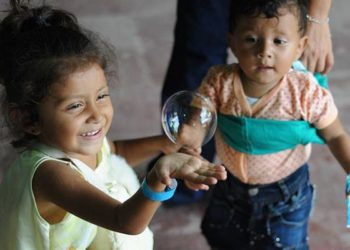Maternal verbal interaction more common than paternal during infancy
1. In this prospective study examining audio recordings of full and late-preterm infants, mothers provided more speech exposure to infants from birth to age 7 months than fathers. There was also more reciprocity among mother-infant pairs, with mothers more frequently responding to infant vocalizations and infants vocalizing more to female speech.
2. Same gender preferences were observed among the parent-infant interactions, with mothers more likely to respond to female infants and a trend of fathers as more likely to respond to male infants.
Evidence rating level: 1 (Excellent)
Study Rundown: Exposure to parent talk, as well as infant vocalization and reciprocity, has been correlated with intelligence and language development in infants and toddlers. Previous studies have shown that girls have earlier language development than boys. This study sought to evaluate the role of both parent and infant gender in verbal interactions between parents and their children through audio recordings at birth, 44 weeks postmenstrual age (PMA), and at 7 months to measure adult word count, infant vocalization and conversational exchanges. Mothers provided a greater amount of speech exposure to their infants and responded more frequently to infant vocalizations compared to fathers. Infants also showed a greater vocal response to speech from mothers. Mothers were significantly more likely to respond to female infants at birth and 44 weeks postmenstrual age (PMA), with similar trends noted in fathers responding preferentially to boys. Though this study is limited by a small sample size and generalizability given exclusion of single-parent households, physicians should be aware of gender differences in parent talk when providing anticipatory guidance to parents.
Click to read the study, published today in Pediatrics
Relevant Reading: Teaching by listening: the importance of adult-child conversations to language development
In-Depth [prospective cohort]: A total of 33 full and late-preterm infants of 2-parent households were included in the study (mean gestational age = 37 ± 2 weeks, 48% male, 31% resided in a bilingual household). Audio recordings were collected at birth, 44 weeks PMA, and 7 months with full length recordings > 10 hours. A language environment analysis system (LENA) was utilized to compare infant vocalization counts, adult word counts (AWCs) and conversational exchanges (measuring reciprocal interactions). Mothers had significantly higher AWCs/hr at birth (1263 vs. 462; p< 0.0001), 44 weeks PMA (929 vs. 366; p< 0.0001), and 7 months (738 vs. 257; p<0.0001). Infants also had a significantly greater response to female-initiated speech versus male speech at birth (11% vs. 8%; p<0.01), 44 weeks PMA (21% vs. 13%; p<0.0001), and 7 months (27% vs. 17%; p<0.0001). Mothers were significantly more likely to respond to female infants compared to males at birth (p=0.04) and 44 weeks PMA (p=0.0003), with a similar trend at 7 months. Though not statistically significant, fathers showed a trend of responding preferentially to male infants at 44 weeks PMA and 7 months.
More from this author: Single-family room model improves NICU outcomes; Pediatric renal and thyroid cancer rates increase; Hydroxyurea not associated with clinically impaired vaccine response; Peer-mentored therapy reduces distress in mothers of children with disabilities; Increased risk of hookah use in urban and high socioeconomic adolescents
Image: PD
©2012-2014 2minutemedicine.com. All rights reserved. No works may be reproduced without expressed written consent from 2minutemedicine.com. Disclaimer: We present factual information directly from peer reviewed medical journals. No post should be construed as medical advice and is not intended as such by the authors, editors, staff or by 2minutemedicine.com. PLEASE SEE A HEALTHCARE PROVIDER IN YOUR AREA IF YOU SEEK MEDICAL ADVICE OF ANY SORT.







![Radiofrequency catheter ablation effective as first-line therapy for atrial fibrillation [RAAFT-2 trial]](https://www.2minutemedicine.com/wp-content/uploads/2014/02/afib_-75x75.jpg)

